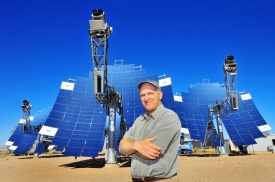Oct 17 2008
Chuck Andraka, Sandia National Laboratories engineer, and Bruce Osborn, chief operating officer of Stirling Energy Systems (SES), were honored with a Popular Mechanics magazine Breakthrough Innovator Award Oct. 15 during a ceremony at the Hearst Tower in New York City.
 Chuck Andraka in front of the Stirling array at Sandia National Laboratories
Chuck Andraka in front of the Stirling array at Sandia National Laboratories
Sponsored by Bristol-Myers Squibb, the Breakthrough Awards celebrate innovations poised to change the world and the personalities behind them. The joint Sandia/SES award is among 21 given by the magazine at the ceremony.
The award recognizes a solar-to-grid system conversion efficiency record the SES Serial #3 solar dish Stirling system beat in January 2008 at Sandia’s National Solar Thermal Test facility. The existing 1984 record of 29.4 percent was toppled by the new 31.25 percent net efficiency record.
The conversion efficiency is calculated by measuring the net energy delivered to the grid and dividing it by the solar energy hitting the dish mirrors. Auxiliary loads, such as water pumps, computers and tracking motors, are accounted for in the net power measurement.
“We are honored to be tapped for this award by Popular Mechanics,” says Andraka. “Gaining two whole points of conversion efficiency in this type of system is phenomenal, and the recognition by the magazine is notable.”
Serial #3 was erected in May 2005 as part of a prototype six-dish model power plant at the Solar Thermal Test Facility that produces up to 150 kilowatts (kW) of grid-ready electrical power during the day. Each dish unit consists of 82 mirrors formed in a dish shape to focus the light to an intense beam.
The solar dish generates electricity by focusing the sun’s ray onto a receiver, which transmits the heat energy to a Stirling engine. The engine is a sealed system filled with hydrogen. As the gas heats and cools, its pressure rises and falls. The change in pressure drives the pistons inside the engine, producing mechanical power, which in turn drives a generator and makes electricity.
Osborn says, “SES is working to commercialize the record-performing system and has signed power purchase agreements with two Southern California utilities [Southern California Edison and San Diego Gas & Electric] for up to 1,750 megawatts (MW) of power, representing the world’s two largest solar power contracts. Collectively these contracts require up to 70,000 solar dish engine units.”
In selecting the candidates and winners of the 2008 Breakthrough Awards program, the editors of Popular Mechanics canvassed a large range of experts and academics to come up with a list of worthy nominees. Members of Popular Mechanics Board of Advisors reviewed the nominations to help the editors of Popular Mechanics choose the winners.
SES was formed in 1996 to develop and commercialize advanced solar technology. The company maintains corporate headquarters in Phoenix, Ariz.; project and technical development offices in Tustin, Calif.; and engineering and test site operations at Sandia in Albuquerque, N.M. The SES SunCatcher is a concentrating solar power (CSP) technology that uses mirrors to concentrate the sun’s energy and convert it to electricity. The dish concentrator tracks, collects and focuses the sun’s energy and the Stirling engine converts the thermal energy to grid quality electricity. The SunCatcher technology has significant advantages including power conversion efficiency, cost competitiveness, and low water usage. The SunCatcher is a zero emission renewable energy technology.